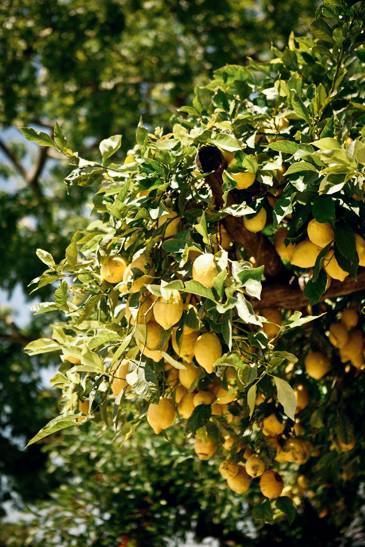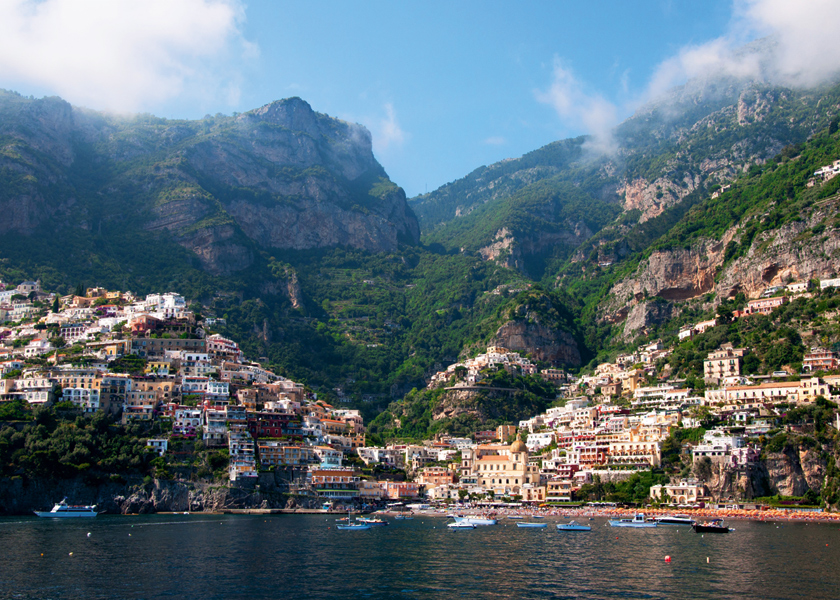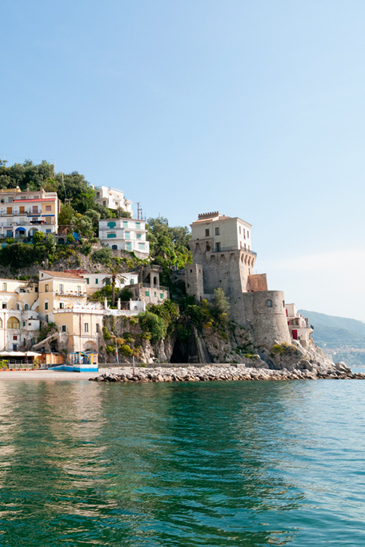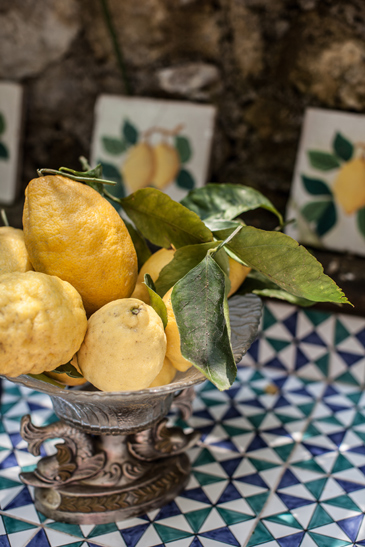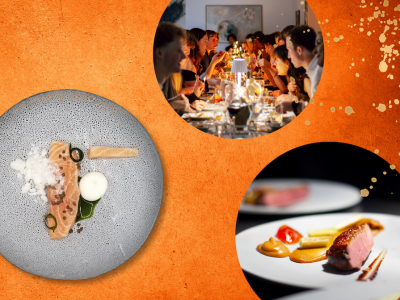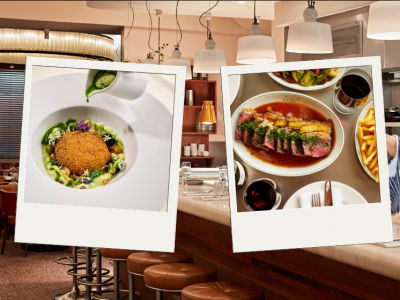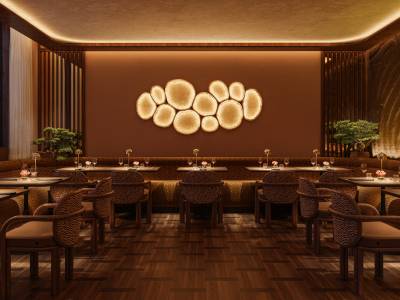I am standing in the lemon groves of Salvatore Aceto in the stepped terraces above Amalfi in southern Italy. The pergolas groan with juicy yellowness, a fragrant, fecund canopy of brightness and sun-capturing life. Salvatore plucks a lemon from a tree, drives his thumb into its juicy flesh and rips it in two, giving me half. “Eat it! Eat it!” he cries. “Eat it whole like an apple!” The zest makes my lips sting and I gulp down the juice that spurts out. “This is L‘unica cosa,” he says.
Zest for life: a guide to the Amalfi Coast
14th March 2014
Italy’s Amalfi Coast is known for its intimate resorts, pastel-coloured houses, flower-strewn cliffsides, sensational seafood—and its scented lemon groves. Lydia Bell enjoys a feast for the senses along the spectacular coastline
“This is our life.” For centuries, the locals have been aware of the gastronomic and medicinal value of lemons. Eaten whole—pith, peel, juice and flesh—they have strong antiviral and immune-boosting properties. “Lemon peel in coffee fixes headaches,” promises Salvatore. “One part lemon juice to two parts water every day gives you a new life. Eat one whole lemon and you’ll be well for six months.”
There is no lemon like the Sfusato Amalfitano. Tagged in 2002 with an Indicazione Geografica Protetta (IGP), testifying to its quality and regional origins, this lemon is large and bulbous with a pointy end and infused with a profoundly scented essential oil. Scratch the skin and it emits its intoxicating essence. They grow on stepped “macerine” terraces held up by dry-stone walls in about 13 main villages along the coast, in rich volcanic Vesuvius soil under the Mediterranean sun. Salvatore shows me their captivating little family museum replete with artefacts such as old lemon baskets, ancient drying racks, coffee grinders and rudimentary grappa-making machines.
Their summer granita kiosk sits in the corner. There are black-and-white pictures of nut-brown Amalfi peasant women stoic under the weight of 60 kilos of lemons on their backs. Before the family built the rudimentary cable car in 1968, it was the matriarchs who would trudge up for the harvest. Their latest venture is cooking lessons on a panoramic terrace. “There’s no wi-fi. You have to relax—and cook. Our motto is, ‘if you can’t cook it, you can’t eat it’,” we are told. Sample dishes, such as smoked mozzarella with lemon leaves and lemon spaghetti and tiramisu with lemon, are described as “nothing too elaborate, it’s all quite simple, just what we eat.” We tear ourselves away from this heavenly spot to pay a visit to Valentino Esposito, who has a tiny, fragranced, limoncello factory in the cliff-set village of Praiano. In the entranceway of Il Gusto della Costa (www.ilgustodellacosta.it), a large pallet of limoncello is sitting in cling film waiting to be shipped to Jamie Oliver. Limoncello is a simple liqueur of lemon skin, alcohol and sugar.
First, 96 per cent alcohol is mixed with hand-shaved peels of lemon for a few days. Valentino shakes a box of peelers at me. “Everywhere I go I buy a peeler! I just came back from England with three!” Then, cold water and sugar is added, and the peel removed, and it’s ready for bottling. Valentino’s leftover peel is used to make marmalades, or goes to a restaurant in Positano for its granita, or is used as marinade for fish. He leans over, whispering “Limoncello for breakfast?” It’s 9.30am but this is a shot of uplifting life and the best we taste on the coast. It’s spring on the Amalfi Coast. From my balcony in Positano, serenaded by the gonging dome of the church, I can survey the volcanic sand beach where pale scoops of fishing boats rest, and gaggles of tourists wait for the pleasure boats that prowl up and down the waters of this dramatic coastline. Houses crawl haphazardly up the sides of the hill and the sky is a hazy blue. The wisteria is flowering and the town and its hills are groaning under the weight of so much lilac drapery.
“This song is about these Neapolitans who go to heaven and say to Saint Peter, ‘Okay, we’ve seen it now, and it’s great, but now we want to go back to Naples,’ explains Salvatore. “You have to understand—Naples is a dump!” He laughs and claps his hands with tears in his eyes. We eat in the hotel restaurant, La Sponda, which does something magic with the produce of Campania—the copious seafood of the coast, inland meats and prodigious vegetables that grow in the blessed Vesuvius soil. The prettiest restaurant I have ever seen, its white arches are decorated with trained vines so you feel like you’re eating in Sleeping Beauty’s castle. Giant candelabras flicker with candles at night. The best dish is the simple spring baby vegetables, executed with simple perfection, each are cooked in a different way, each with the perfect degree of crunch. The next morning, the head chef, Matteo Temperini, who earned a Michelin star here in 2012, admits me into his sanctum sanctorum. Unwittingly fulfilling one of my culinary fantasies (being fed perfect tidbits by a handsome chef), he gives me warm crab that melts on the tongue, and an embarrassment of gelatos: creamy, black-flecked Madagascan vanilla, authentic pistachio, delicate hazelnut and rich 70 per cent cocoa chocolate. Another day, another Michelin-starred meal. We pop over to Sorrento, to feast once more, this time at Hotel Excelsior Vittoria. Built 180 years ago by the Fiorentino family, it has remained in their hands ever since. The faded, beautiful hotel is possibly the most grandiosely enchanting on the coast with its belle époque music room and sumptuous frescoes. Its grand balcony overlooks the deathless horizons of the Gulf of Sorrento and the Bay of Naples, Vesuvius brooding in the near distance. By contrast to the hotel’s upstairs beauty, the downstairs restaurant Terrazza Bosquet is a blank, featureless room. However, it hardly seems to matter when you are feasting on the best food you’ve ever eaten. The hotel’s chef, Luigi Tramontano, was given a Michelin star in November and his kitchen has just reopened for the season. From the bread basket (seaweed crostini, lemon bread, fennel seed bread, truffle and parmesan bread) to sweet cubes of pistachio-encrusted tuna and a flyway-light spin on the local classic Delizia al Limone (a sponge filled with lemon cream), Tramontano’s food sings.
We are staying in the 58-room-and-suite Le Sirenuse hotel. From the soul-lifting, boundless views, to the old-fashioned perfection of the antique furniture and paintings, the beautiful baroque bar, the giant, triffid-like palms, the mini lemon and orange trees lining the swimming pool, and the happy and big-hearted staff—this may be my new favourite hotel. The hotel’s secret weapon is owner Antonio Sersale, a man who transmits joy like an infectious disease. I first encounter him sitting with a group of his friends and family listening to a guitarist and a man with a fine mullet named Frank Americano playing the mandolin and singing Neapolitan songs.
Our final pitstop is Ravello, where we check into Belmond Hotel Caruso, a former 11th-century, frescoed palace set on epic cliffs with a cloud-suspended infinity pool. At the bar, Tomasso Mansi, the charming head barman—and son of a lemon farmer—shows us how to prepare cocktails that make use of the local lemons. He starts with the simple, zesty fresh lemon juice—lemon, water and sugar—that is the signature summer drink of the coast. “This puts you in touch with the land,” he says. “You drink this, and you say, ‘Now I am on the Amalfi Coast!’” Next, the Orizaba, the “posh” lemonade. Served in a fresh mint-filled glass, a few drops of almond syrup are joined with lemon juice, creating what he calls the Amalfi Coast Mojito, “the bestselling poolside drink here in summer”. Then the serious business starts: the Caruso Spirit (with Aperol, Campari and Limoncello with a Prosecco finish), and my favourite, the Gimlet Caruso (gin or vodka shaken with Tomasso’s secret-recipe lemon cordial). As he works, he tells us about his family’s 2,000-tree lemon grove. The family has always cultivated lemons, he says, but the only one who makes money now is the middleman. Families sell the lemons at 50 cents (40p) a kilo. “I think that this generation will be the last, that it will disappear. Because it’s better to be a worker for €60 a day than run your own business.”
That evening, we meet Mimmo di Raffaelle, the head chef. He plies us with deep-fried stuffed anchovies, mini bruschetta and a savoury version of sfogliatella pastries as he explains the importance of lemons to his cooking. “Lemons are key. You must try agrumi della costiera, a mixture of cider and lemon, and the linguine with lemon, and the potato-stuffed tortelli with lemon zest. Oh! And Variazione di Limone, which is many lemon-based puddings, pannacotta, cannolo, lemon crème, meringue and sorbet.” Only local produce is used. “Now, it’s typically fashionable to talk about local this and local that, but for me it is not a fashion, it is the way I like to showcase my culture,” he says. “Like our sweet San Marzano mini plum tomatoes. They are not ready for passata-making yet, but they are good for bruschetta. We have six types of tomatoes in a 30km radius.” We migrate to a palm-filled room with dusky-pink upholstery and original fired-tiled pieces. I eat salty-fresh linguine all colatura, tossed in a “colatura” sauce of anchovies and lemons.
Mimmo pops out to check everything is all right. We also end up meeting Gaetano Amato, the head gardener. The product of four generations of gardeners, he takes interested guests on tours of the stepped gardens he has created from nothing since 2005. It is a symphony of composition, designed to reveal its Mediterranean beauty bit by bit as the seasons change. As the wisteria subsides, the jasmine blooms. When the iceberg roses wither, the Russian sage comes out.
We walk through the passeggiata, lined with Japanese apple trees crowned with white blossom, edged with white pansies, and under wisteria-drenched pergolas. Gaetano, whose great grandfather worked for Lord Grimthorpe, the British owner of Ravello’s Villa Cimbrone, says he feels indebted to the British aristocrats, intellectuals and garden lovers who arrived during the days of the Grand Tour. They brought the notion of the decorative garden to this rocky-rustic corner of Italy and the seeds of palms and other exotic plants. Leaving Gaetano, we go for a walk.
Grimthorpe developed the villa’s six-hectare parkland from the end of the 19th century to the early 20th. Fountains, nymphs, pavilions and statues mingle with English-style flowerbeds. The pièce de résistance is his Terrace of Infinity, where you gaze out past 18th-century marble busts and mountains towards the sea. Grimthorpe bought the hilltop estate in 1904 while trying to recover from depression after the death of his wife. Its restoration brought him immense happiness. It would for anybody. This is a serendipitous place, where everything spells culture, food, human charm and sweet romance.
Amalfi Coast where to stay
Classic Collection Holidays offers four nights on the Amalfi Coast with two nights at Le Sirenuse (www.sirenuse.it) in Positano, two nights at the Belmond Hotel Caruso (www.hotelcaruso.com) in Ravello and one day at the Grand Hotel Excelsior Vittoria (www.exvitt.it). Flights and private transfers included. For more information, visit classic-collection.co.uk or call 0800 294 9318.
Photography Credits: Alamy; Getty; Helen Cathcart, Shutterstock, Moment Open/Getty, Corbis, Eyevine
